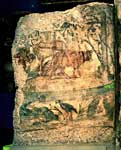 | | 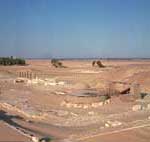 | | 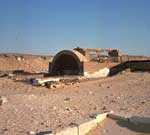 |
| |
A Roman fresco exhibited in Alexandria, Egypt
A fresco found in Alexandria in 1960 illustrates one of the worlds' oldest machines. It was found in a necropolis but its dating presents a puzzle to scholars.
Probably the artist made his fresco at a time between 100 B.C. and 100 A.D.. The Romans and the Greeks worked with two sets of machine designs. The first category belongs to those we will call ingenious toys. The other category was different sorts of "mills". They were very rare. The watermill was almost unknown and the noria was a new invention. The fresco from Alexandria is our first record of the water-lifting wheel. The fresco is in the Graeco-Roman Museum in Alexandria, Egypt. Photo Th.Schiöler 1964.
[107] | | Ruins of a two-thousand–year-old sâqiya in Egypt
In the centre of the site, we can see the well and on the right the noria. From the deep well - which is covered with modern boards - the water was raised and used to irrigate a garden with a few palm trees.
[108] | | Ruins of the sâqiya at Tuna el Gebel, Egypt
The ruined gearwheel is a reconstruction from about 1935. A great part of the brickwork has been repaired, but the roundheaded dome is original. Below it, in shadow, water could be drawn from three taps.
[109] |
|
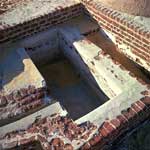 | | 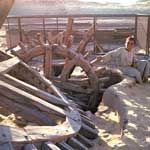 | | 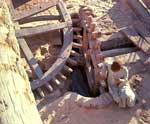 |
| |
Original brickwork forming a small tank
This is a very small reservoir holding no more than two cubic metres. The noria of today has a cistern with a capacity of one hundred cubic metres. The height to which the water is raised is ten times greater, so there is no need for a large cistern.
[110] | | The reconstructed gear wheel
The reconstructed gearwheel is probably taken from an abandoned modern sâqiya. The wheel is too bulky. The Roman wheel-diameter must have been two thirds that size. The technical term in Egypt for the noria is the sâqiya.
[111] | | The reconstructed right angle gear
From a quarter of the big wheel rim, we can calculate that there must have been in total 48 cogs. In a Greek papyrus from 440 A.D., there is mention of one with 36 cogs.
[112] |
|
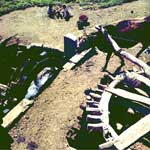 | | | | |
| |
A sâqiya near Cairo
The main features of the sâqiya have not changed much in two thousand years, but the final solution was not reached in one day, in fact, it took a few centuries to develop.
[113] | | | | |
|